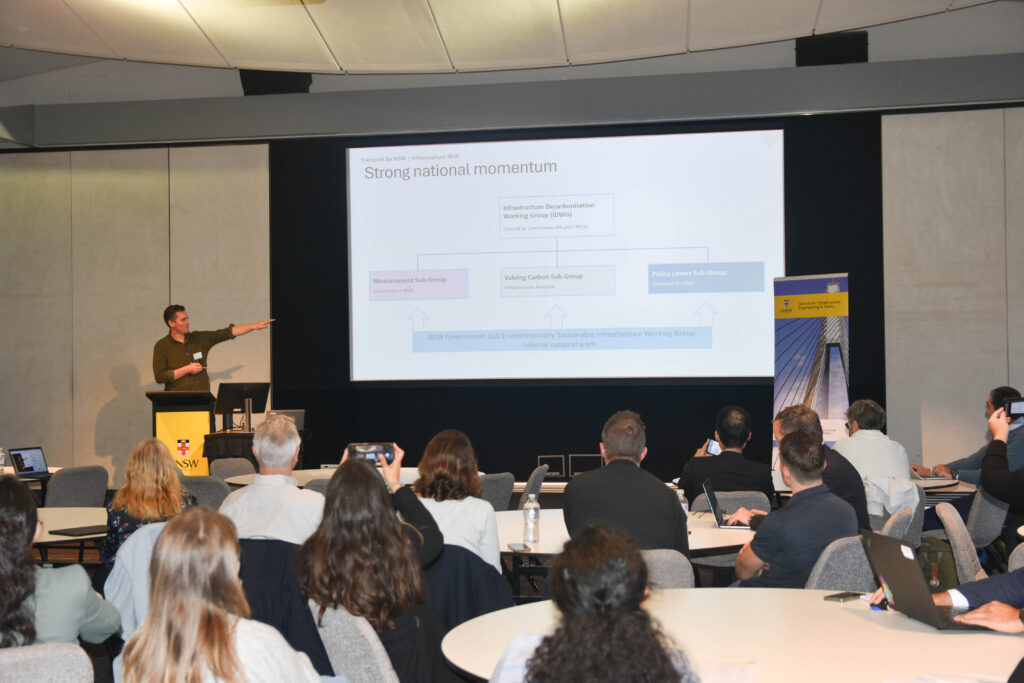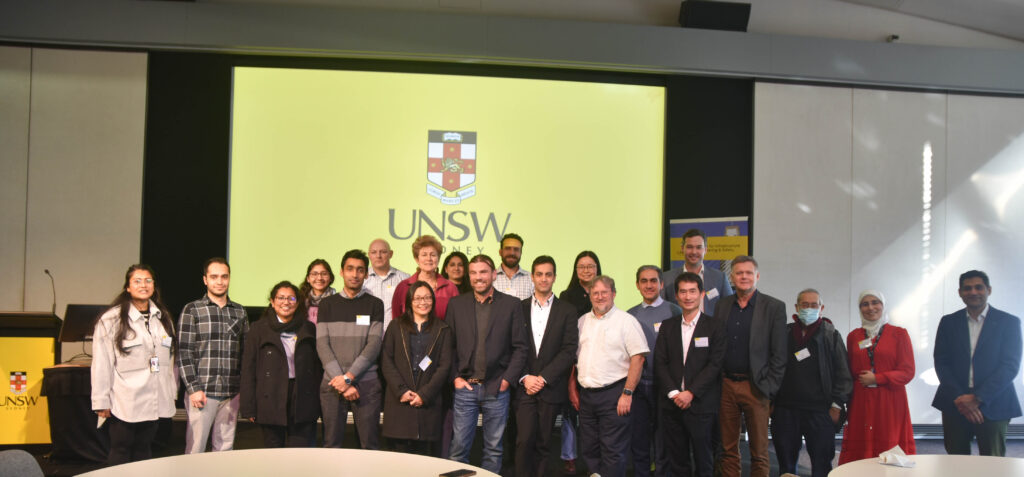Event date: June 28, 2024
The Concrete Decarbonisation Forum, held on June 28, 2024, at the University of New South Wales in Sydney, brought together leading experts, policymakers, and industry innovators to discuss and present groundbreaking strategies for reducing the carbon footprint of the concrete industry (see the whole day’s description through this link). The event featured a series of insightful presentations that showcased a variety of innovative approaches and collaborative initiatives aimed at promoting sustainable concrete production. From global collaboration efforts to corporate carbon budgeting, and from low-carbon concrete mixes to the use of recycled aggregates, the presentations highlighted the latest advancements and actionable strategies for achieving a more sustainable future in the building sector.

Professor Tuan Ngo and Dr Behzad Rismanchi, Professor & Senior Lecturer at the Department of Infrastructure Engineering, The University of Melbourne & Convenors of Decarbonising the Building Industry (DBI)
DBI is a government initiative started in 2023, to form collaboration of universities and industry partners globally. The mission is to drive innovation and implementation in reducing the carbon footprint of the building industry. The consortium, including partners such as the University of New South Wales, Western Sydney University, Monash University, and UCL London for a four-year program. Upcoming events include conferences and policy discussions to improve collaboration, knowledge sharing, and policy recommendations. The focus areas include policy, design, materials, operational technology, and education. The next main event is the DBI2024 international conference in November 2024 (https://rndbi.org/dbi2024-international-conference/).
David Kelly, Director of Engineering Sustainable Infrastructure at Transport for NSW
In late 2023, Transport for NSW launched net zero on climate change policy and the Sustainable Infrastructure Program to operationalise construction and investment decisions. The policy is to be fossil fuel-free in construction and maintenance by 2040, with annual embodied emissions reaching net zero by 2045. They updated their decarbonising infrastructure delivery roadmap and collaborated with National Highways England on carbon accounting and infrastructure contracts. Initiatives include developing a carbon management system aligned with national standards and integrating carbon and cost management into project lifecycles through standardised global guidelines.
Monica Richter, Senior Manager Low Carbon Futures at WWF & Co-Chair of MECLA
The discussion highlights the need for broader decarbonisation efforts. A community of practice around science-based targets focuses on corporate carbon budgets and Scope 3 emissions. Since 2016, Australia’s renewable electricity market has grown significantly. The MELCA promotes collaboration to decarbonise building materials. Demand measurement, knowledge sharing, and system intervention are crucial. Government policies drive change, requiring adherence to embodied carbon targets.
Evan Smith, National Sustainability Manager at Holcim & Co-chair of Cement and Concrete Working Group at MELCA
Significant progress includes the release of Australia’s first EPD for ready-mix concrete in 2019, with global warming impact data now available from 12 companies and 6 cement manufacturers. Low-carbon concrete mixes were identified with as low as 155 kg of CO2 per cubic meter for 32 MPa concrete. MELCA’s concrete and cement working group has developed guidelines for low-carbon concrete. The guide defines low-carbon concrete, provides instructions, and highlights the need for supply chain engagement and cost considerations. Data analysis helps set targets and empowers the industry to reduce emissions further.
Erin Miller, Sustainability Strategy and Innovation Analyst at Laing O’Rourke
Laing O’Rourke Australia, an international engineering construction firm, has prioritised reducing carbon emissions, particularly from concrete, which constitutes a significant portion of scope 3 emissions. They have implemented concrete carbon limits, including a maximum carbon tolerance and a low carbon threshold, to guide their procurement strategies. These limits aim to ensure that all new projects meet specified low-carbon targets. By focusing on embodied carbon metrics rather than percentage SCM targets, they aim to achieve substantial reductions in carbon emissions across infrastructure projects.
David Eyre, CEO of the Institute of Industrial Decarbonisation at UNSW
The UNSW’s IID focuses on deep decarbonisation, addressing the complexity of industrial greenhouse gas emissions. With extensive industry partnerships, the institute prioritises research. The advisory committee includes industry leaders like Engineers Australia, the United Nations, the International Universities Climate Alliance, etc. Research areas include clean technology for critical materials, integrated carbon accounting, pathway modelling, and clean energy generation. The initiative aims to develop a viable, economically grounded transition strategy for Australia’s low-carbon future.
Stephen Foster, Professor at the School of Civil and Environmental Engineering at UNSW
Cement contributes around 6% of global CO2 emissions, varying based on production methods and sources like limestone calcination and energy use. Efforts focus on integrating low-carbon alternatives, facilitating faster adoption in infrastructure projects, crucial for mitigating climate impacts. The design of geopolymer and alkali-activated binder concrete structures, SA TS 199:2023 is developed to facilitate the usage of SCMs.
Dr Ali Kashani, Senior Lecturer at the School of Civil and Environmental Engineering at UNSW & Co-chair of the Cement and Concrete Working Group at MELCA
The presentation highlighted ongoing efforts at UNSW to reduce embodied carbon in concrete through various innovative approaches. Key strategies discussed: optimising concrete design for reduced material use, incorporating SCMs like fly ash and slag, exploring alternative binders such as geopolymers and alkali-activated materials, and implementing carbon capture and utilisation technologies. These efforts aim to achieve significant carbon reductions while ensuring structural performance and durability. Practical pathways for industry adoption were discussed, emphasising early industry engagement and government support for research commercialisation initiatives.
Vivian Tam, Distinguished Professor and Associate Dean at Western Sydney University
The presentation emphasised integrating low-carbon concrete with recycled aggregate to achieve both environmental and circular economy benefits. Replacing traditional with recycled aggregates (from demolition waste), and treating it with CO2, not only reduces carbon emissions but also enhances material performance. This innovation aims to commercialise sustainable building materials while addressing technical challenges and fostering industry adoption through ongoing standards development and partnership engagements.
Clare Tubolets, CEO of the SmartCrete CRC
SmartCrete CRC, a cooperative research centre funded by the Australian government, focuses on decarbonising the concrete sector through collaborative research. Their approach spans three main programs: sustainability, which addresses concrete mix composition and clinker production; engineered solutions, focusing on innovative concrete use in designs to reduce carbon footprint; and asset management, aiming to extend infrastructure lifespan through advanced sensing and rehabilitation technologies. They emphasise overcoming market barriers alongside technical challenges to accelerate the adoption of sustainable concrete solutions in Australia, highlighting the importance of industry collaboration and innovative funding opportunities.
The presentations at the Concrete Decarbonisation Forum illustrated the significant strides being made in the quest for a sustainable concrete industry. By showcasing a blend of innovative research, practical applications, and collaborative initiatives, the speakers provided a comprehensive overview of how the industry can effectively reduce its carbon footprint. These presentations not only highlighted the challenges but also offered actionable solutions and inspiring examples of what can be achieved through dedicated effort and collaboration. As the concrete industry continues to evolve, the insights and strategies shared at this forum will undoubtedly play a crucial role in shaping a greener, more sustainable future.

